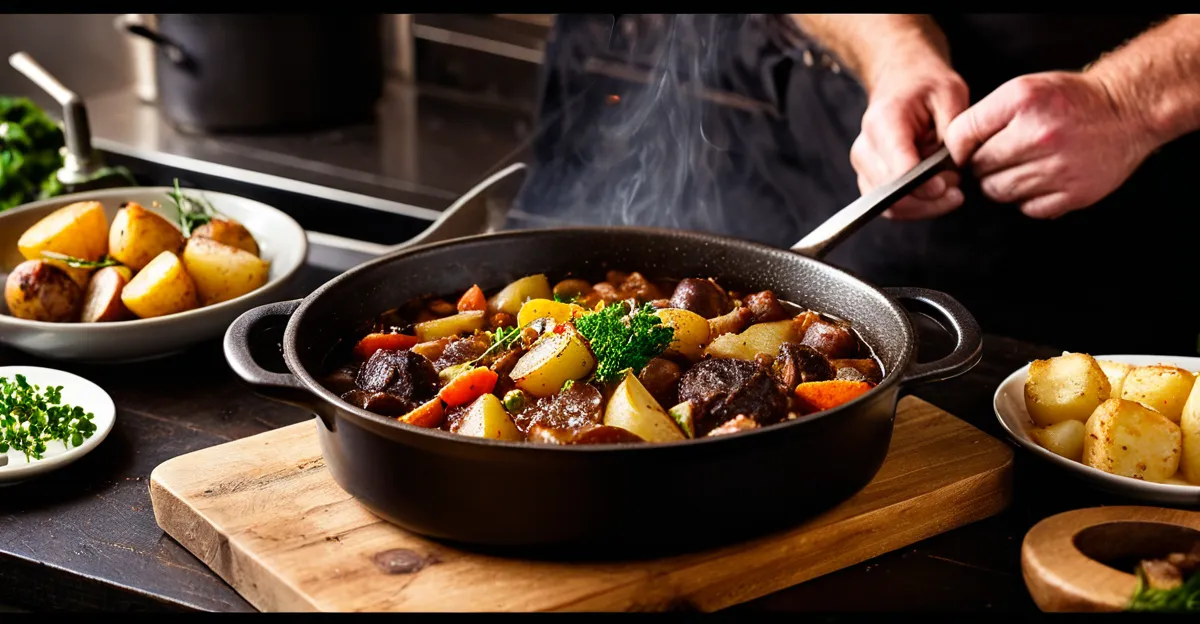Key elements of authentic Lancashire hotpot
Authentic Lancashire hotpot is defined by its simple yet hearty ingredients and traditional preparation. The essentials include tender strips of lamb, sliced onions, and a generous topping of thinly sliced potatoes. These components create the foundation of Lancashire hotpot essentials that distinguish it from other stews or casseroles. Using lamb is crucial, as it imparts a rich, robust flavour that aligns with traditional Lancashire recipes.
The onions play a vital role, providing sweetness and moisture as they cook slowly, melding perfectly with the meat. Potatoes form a crispy, golden crust on top when baked, a visual and textural hallmark of the dish. Local produce remains integral; sourcing quality lamb and fresh onions from Lancashire’s farms ensures authentic taste and adheres to the dish’s roots. This reliance on local ingredients not only enhances flavour but also respects the cultural heritage embedded within authentic hotpot ingredients.
Also to read : What Are the Must-Know Tips for a Perfectly Brewed British Tea?
In essence, these three key components—lamb, onions, and potatoes—combined with fresh, local produce, form the backbone of a genuine Lancashire hotpot. Recipes that maintain these ingredients stay true to the traditional Lancashire recipes cherished in the region.
Traditional preparation and layering techniques
Understanding the hotpot preparation steps is essential to achieving an authentic Lancashire hotpot. The process starts with preparing the lamb, cutting it into tender chunks that cook evenly. Following this, sliced onions are layered meticulously over the meat, allowing their sweetness and moisture to infuse the dish during the long cooking process. Thinly sliced potatoes are then arranged on top, creating the classic crispy crust that characterises the dish.
In the same genre : How do you achieve the ideal texture for a creamy bread and butter pudding?
The layering method is critical—not just for flavour but also for texture. Placing the lamb at the base ensures it remains juicy as it simmers in its own juices and stock. Onions above the meat act as a natural barrier, releasing moisture gradually while softening the lamb. The potato topping locks in the heat and helps the steam circulate beneath the crust, giving the dish its distinctive golden finish.
Traditional Lancashire cooking methods involve using an ovenproof pot or casserole dish with a tight-fitting lid. This cookware retains moisture and evenly distributes heat, allowing the ingredients to cook slowly and meld together harmoniously. Baking the hotpot slowly at a low temperature, often for two to three hours, perfects the tender texture and develops the deep flavours synonymous with traditional Lancashire recipes.
In sum, mastering the layering method and respecting the hotpot preparation steps ensures that the combination of lamb, onions, and potatoes transforms into a comforting and authentic Lancashire dish. This technique upholds the legacy embedded in authentic hotpot ingredients and time-honoured cooking styles.
Secrets and tips from Lancashire experts
Local Lancashire cooks emphasize the importance of patience and using authentic cooking secrets to unlock the full potential of Lancashire hotpot. One expert hotpot tip is to prepare a rich, homemade stock from lamb bones and vegetables, which enhances the dish’s depth of flavour beyond what plain water can achieve. This slow cooking process, central to expert hotpot tips, allows the lamb to become incredibly tender while infusing the casserole with a robust, savory base.
Another secret involves carefully controlling moisture during cooking. Traditional Lancashire cooks advise against adding excess liquid too early. Instead, allowing the ingredients’ natural juices to release gradually during the long bake preserves the harmony between meat, onions, and potatoes. This approach supports maintaining the ideal texture throughout, ensuring the perfect crust forms on top without sogginess beneath.
Achieving the distinctive golden potato crust demands attention to detail. Applying a light brush of butter or fat on the sliced potatoes before baking can encourage browning and crispness, a trick shared among local Lancashire cooks. Such nuances demonstrate how subtle techniques passed down through generations contribute significantly to the authentic Lancashire hotpot experience.
In summary, these expert hotpot tips—rich homemade stock, moisture management, and finishing touches on the potato topping—highlight the traditions that distinguish genuine Lancashire hotpot from lesser versions. Following these insights from seasoned local cooks helps preserve the authenticity and cherished flavours embedded in traditional Lancashire recipes.
Distinguishing authentic hotpot from modern adaptations
A fundamental question often arises: What distinguishes authentic Lancashire hotpot from modern variations? Authentic Lancashire hotpot strictly adheres to traditional recipes vs variations by maintaining the core ingredients—lamb, onions, and potatoes—prepared using time-honoured methods that reflect the region’s culinary heritage. Deviations typically occur when modern adaptations introduce non-traditional ingredients such as other meats, extra vegetables, or alternative toppings, which dilute the dish’s original character.
Key indicators of Lancashire hotpot authenticity include a slow-cooked lamb base enriched by a homemade stock, a carefully layered assembly where lamb rests beneath onions and the potato crust, and a rich yet simple flavour profile that honours its northern English roots. Recipes that compromise these elements often result in versions that lack the distinctive depth and texture that define the authentic hotpot experience.
Many adaptations stray from tradition because of convenience or modifying taste preferences. For example, quicker cooking times or oven methods that skip the layering method can lead to uneven cooking and a soggy potato topping. Similarly, substituting lamb with beef or poultry shifts the flavour away from the deeply savory notes central to authentic Lancashire hotpot. Understanding these differences helps preserve the culinary integrity of the dish and applaud those recipes that honour traditional recipes without compromising its essence.
Serving suggestions and regional variations
Lancashire hotpot serving traditionally involves presenting the dish hot from the oven, allowing the crispy potato crust to retain its golden texture. It is often accompanied by simple, hearty side dishes that complement the robust flavours of the hotpot. Common traditional accompaniments include buttery mashed potatoes, mushy peas, or seasonal root vegetables, each enhancing the meal’s comforting and rustic nature.
Regional twists within Lancashire occasionally introduce subtle variations without compromising the core identity of the hotpot. Some areas might incorporate herbs such as thyme or bay leaves into the authentic hotpot ingredients to add depth, while others might subtly vary the cut of lamb used, all within the bounds of traditional Lancashire recipes. These differences reflect local preferences and available produce, highlighting the diversity within a single culinary tradition.
Understanding the typical Lancashire hotpot serving style and regional nuances helps appreciators distinguish between minor variations and fundamental alterations. Consistently, the emphasis remains on preserving the essential ingredients and slow cooking approach, ensuring each serving honours the heritage of Lancashire’s signature dish.





